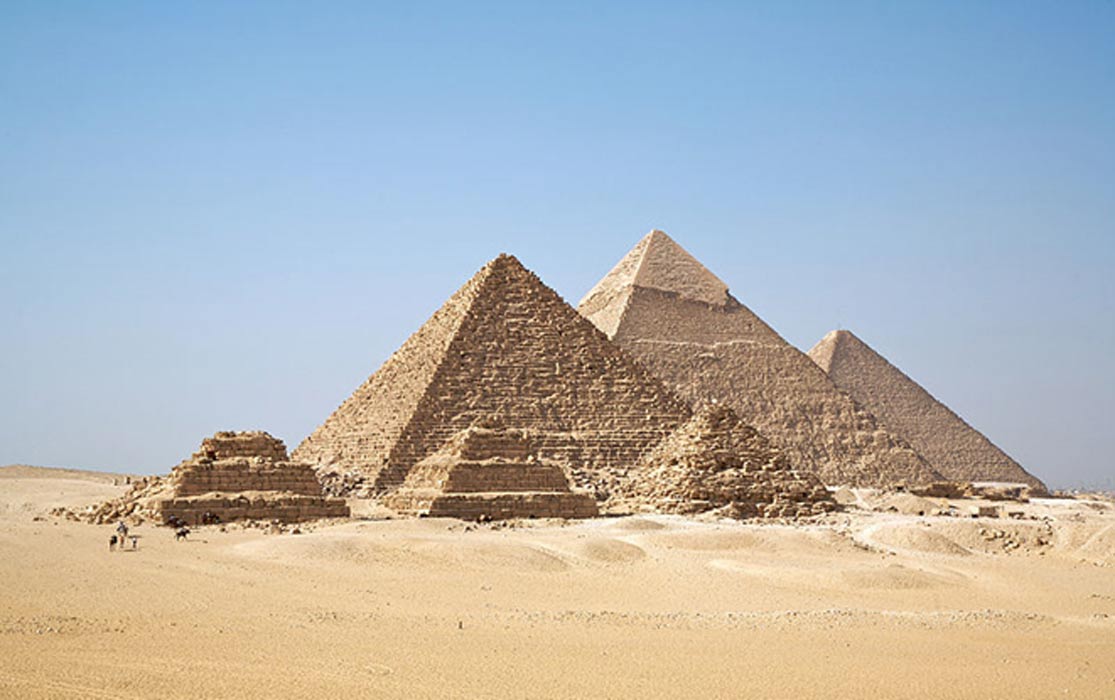
Queens Pyramids and the Zep Tepi: Primary Planning During the Apex of the Golden Age
Since the beginning of the nineteenth century and for the middle of the twentieth, an excessive and erratic haste to visit and explore ancient Egyptians ruins took place, as if the Ultimate Truth on mankind’s distant past could emerge from the ancient sands of Egypt. This Gold Rush culminated in the late forties, when the imaginary curve on the Cartesian’s axes, crept down, slowly, inexorably, plummeting to the lowest point in modern times.
Nevertheless, there are many mysteries yet to be discovered.
Mysteries, Investigations and Assumptions
A description of the Giza Plateau is a very difficult exercise. Those of us who had the opportunity to visit the wonders of Egypt will be able to confirm how many buildings were erected in the desert sands, during the pre-dynastic and dynastic age; An heterogeneous system of monuments, houses, warehouses, clefts, wells integrated into a whole, like lines of a poem from ancient times.
Giza is the absolute definition of the chaos theory; dominated by two types of buildings, very different in shapes and functions: the pyramids and their giant fences, and the Sphinx and its majestic temples.
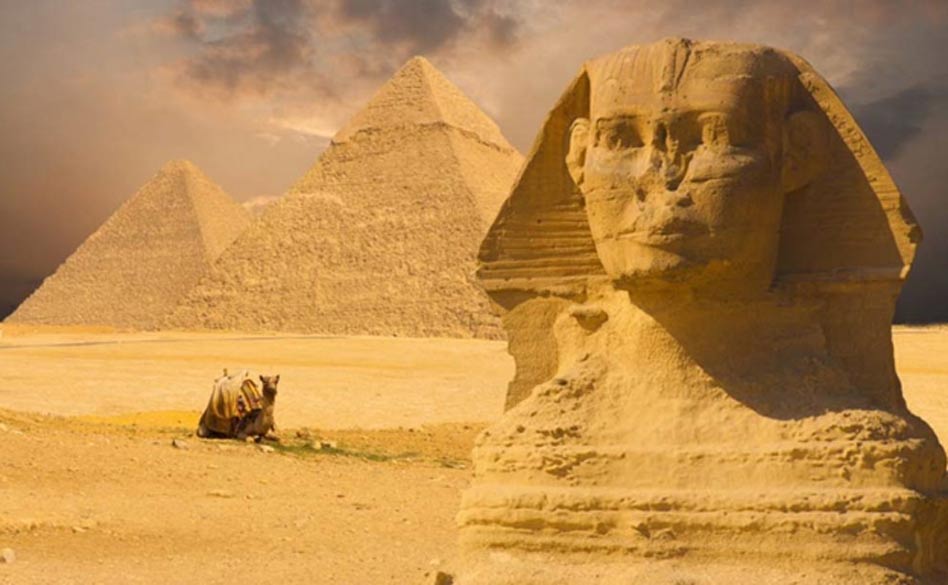
The Sphinx and Great Pyramids of Egypt. (Source: BigStockPhoto)
For centuries, those mysterious buildings drew researchers’ attention and tourists’ interest. At the same time, scholars tried to make sense of the meaning of pyramid architecture, with negative results.
In the past, scholars and alternative researchers wrote many archaeological treatises and voluminous books on the wonders of Ancient Egypt and, particularly, on the pyramids of Giza, driving the mind beyond the bounds of all imagination, to solve the mysteries of the most famous archaeological site in the world.
Nevertheless, Egyptologists did not yet achieve the correct interpretation of the monuments’ function. I think that all hypotheses, theories, intuitions, assumptions so far widely proposed, are fueled by factors independent of archaeological evidence. The absence of a unique method of investigation, partly due to the shortcomings of protocol procedures, makes less and less believable all theories proposed both by scholars and by alternative researchers.
Differentiation among “school of thought” is a further example of what must never again be allowed to happen. In fact, its only mission is to confuse the matter even further, in a field under constant review, but without any scientific credibility. The many factors influencing archaeology are inspired by personal conflicts and not by a sense of pure professional duty.
Not in the Club
The Orion Correlation Theory, proposed by Robert Bauval in 1994, at the same time, is a typical example of that, and an exception due its contents. Without getting into the argument of whether or not his purpose is the most desirable, it is to be noted that debate among scholars is held within the limits of his university education and not on scientific contents of his theory. That is an extremely worrying sign; message is loud and clear: nobody can do research on the mysteries of antiquities if they are not part of a private caste.
Archaeology, and especially Egyptology, are exclusively matters for handful of puppeteers, who want you think the Great Pyramid is a dynastic tomb. This clearly demonstrates scholars’ ignorance in historical and religious funerary rituals during the Ancient Kingdom.
Even now Egyptologists are still publishing academic texts from which involve sloppy considerations about pyramid building methods; with their proposals they are humiliating people with the skill of analysis, even of the most unschooled. Not only that, but scholars’ theories are increasing doubts with the presence of many archaeological, historical and technical inconsistencies. Archaeologists’ discussions in this area occasionally remind me of disputes in ancient Byzantium on the sex of angels.
Welcome to Orion Correlation Theory
Under desert sands and all around the monuments of Giza there are many enigmas to be solved.
Therefore, some alternative researchers with their new proposals are welcome; they are making very important contributions of ideas and results, giving solutions in line with the scientific and archaeological finds.
Finally, welcome to the Orion Correlation Theory showing correlation between the major Pyramids of Giza and the Belt of Orion.
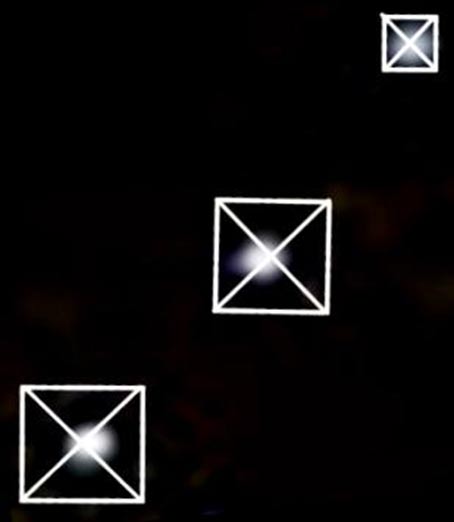
Representation of the central tenet of the Orion Correlation Theory: the outline of the Giza pyramids superimposed over a photograph of the stars in Orion's Belt. (Davkal, CC BY-SA 3.0)
Theories are the apex of a scientific process marked by new scientific applied methods, used to discover the mysteries of ancient civilizations. It is like a new tool to remind us of the heritage of civilizations who lived the planet in the distant past. It is a gift to humankind; a kind of vibrational benefit, putting mankind in frequency with themselves and with the past, from where they came.
Bauval’s theory suggests an investigation – so easy as to be natural – on the arrangement of the Pyramids in correlation with the three stars of the Belt of Orion in a specific ancient age. A very complex matter is disputing two centuries of scholars' hypothesis about the monuments functions.
A Lost Civilization
The Great Pyramid is not a tomb. To state this as fact is an offense not only against history, but against humanity.
The arrangement of the shafts—built into the so-called Chamber of the King and of the Queen—is not a coincidence. The shafts were built to connect the monument to the north constellations, the Sirius and Orion Constellation. Another shot at humanity’s history is to deny the existence of a ‘Primary Planning’ characterized by other monuments and not only by pyramids and the Sphinx.
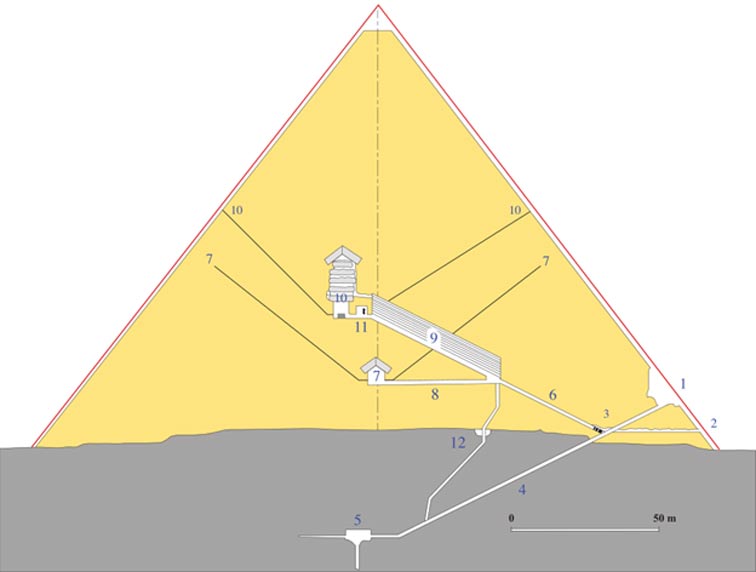
Schematic cross-section of the Great Pyramid. (7 denotes Queen's Chamber and shafts/vents, 10 denotes King’s Chamber) (CC BY-SA 4.0)
Scholars’ continuing endeavors are extremely serious, in the effort to silence the existence of a lost civilization, which originates from prehistory, proving their high level of technological knowledge. They handed down a message as a proof of their time on Earth, through the mysterious buildings spread all over this planet, surviving continental devastations occurring between 11,000 and 9,000 BC.
Assuming Bauval’s theory is scientifically correct, we must affirm that his assumptions tried to open up new shocking horizons, giving a scientific meaning to the existence of the lost civilization, of the pyramids, and of the ancient societies who built majestic monuments all around the planet, as splendid testimony to artistic and technological progress achieved.
Nevertheless, I would like to highlight certain points I believe to be of particular importance concerning his proposal, because I point to an inconsistency which misrepresents the very purpose of the monuments of Giza.
The Limits of a Theory
The alignment time factor between stars and monuments is the first limit of Bauval’s theory. According to his suggestions, the monumental complex of Giza finished in a period very close to Egyptian dynastic age. He argues that human beings’ evolution is a perfect reference point to establish a correct timeline, supporting, as a matter of fact, Darwin’s evolution theory, whose shortcomings are well-known about Sapiens and Neanderthal interbreeding.
That limitation is a significant impediment to the comprehension of the entire project and of the many artifacts pushing back in time the origins of the pyramids civilization, as can be seen by the interpretation of the Sumerian Tablets by Zecharia Sitchin. In fact, the Sumerian tablets told of the existence of the Egyptian pyramids in a very distant past.
The second is a technical limit. His theory is founded on the major monuments of Giza, i.e. the pyramids and the Sphinx, as referral points. However, all monuments must be found to better understand the ancient message coming from the distant past of the Giza Plateau. All monuments which were included into the Primary Planning.
During my investigation across the desert sands of Giza, I pieced together the observation points and the correlations to the sky, detecting the two missing links in the tomb of the Queen Khentkaus and the so-called Tomb of Birds. Both monuments lie in very specific position, with reference to the pyramids and the Sphinx, the first connected to a very important star for the Ancient Egyptians, the second connected to the constellations lying in the west of the sky, completing the geographic cardinal cycle.
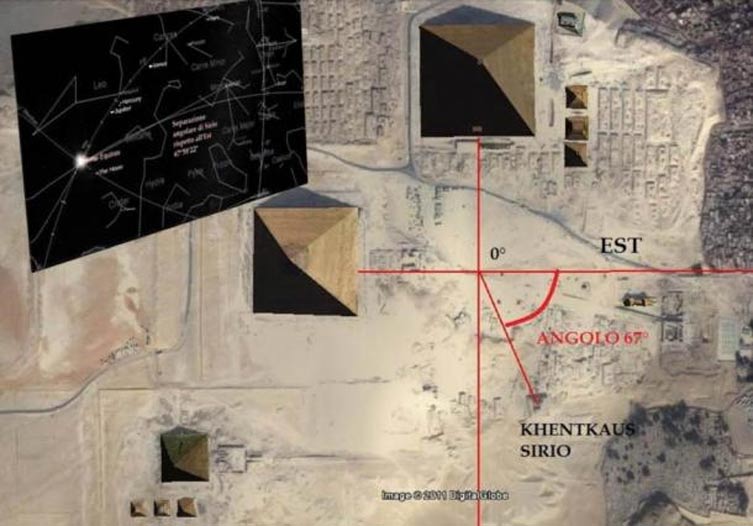
Lost Tomb of Khentkhaus is the correspondent of the Star Sirius (Image courtesy Armando Mei)
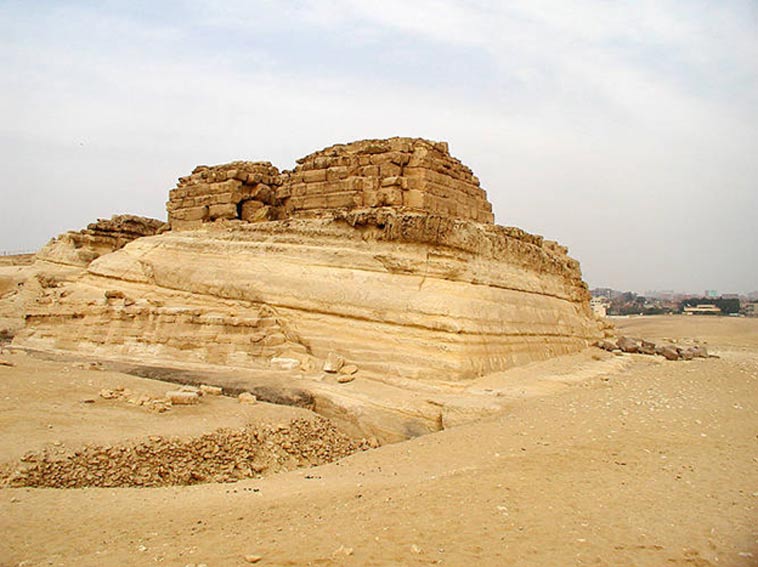
Tomb of Khentkaus I in Giza (Public Domain)
Pyramids of the Queens
Lastly, a special reference also needs to be made to the role of the so-called Satellite Pyramids or Pyramids of the Queens. In 2010, they were the subject of my first investigation into the mysteries of the Ancient Egypt, which concluded with publication of my first book: “Satellite Pyramids and the Secret Code”, in Italian language. I proposed a complex analysis, a logical sense of the minor monuments’ arrangement, as they’re close to the major ones.
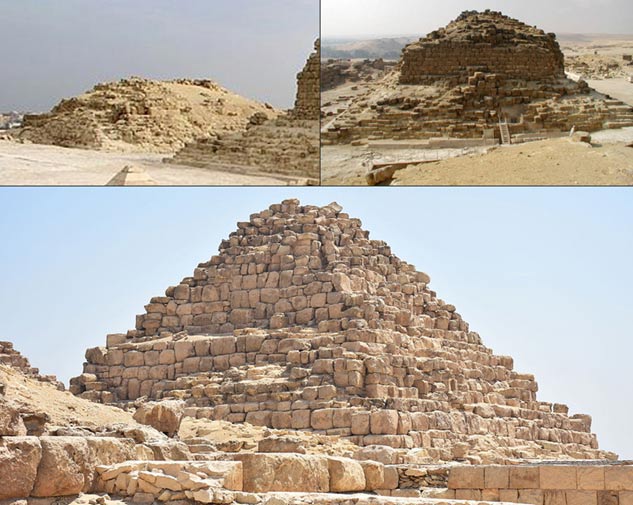
The Queen’s Pyramids of Giza. Top left, G1a “Queen Hetepheres”, Top right G1b “Queen Meritites”, and Bottom G1c “Queen Henutsen.”
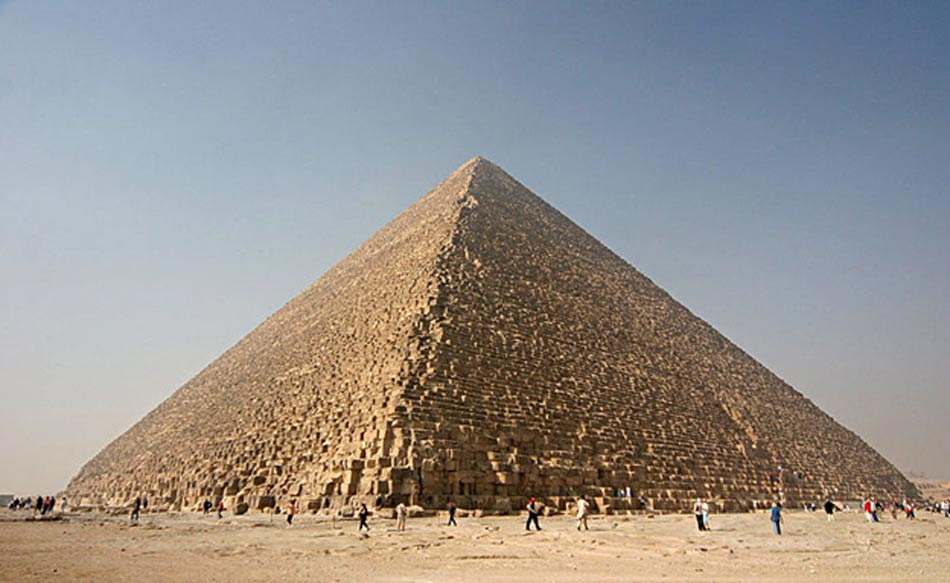
The iconic Great Pyramid of Giza. (Nina at the Norwegian bokmål language Wikipedia, CC BY-SA 3.0)
In 2003, I was still in a stage of early development of my theory, and I rather took what Robert Bauval was saying about the symbolism of the Pyramids of the Queens. Minor buildings were passed over by all scholars and alternative researchers; however, their purpose is connected to the Primary Planning, considering the monuments of Giza as a whole.
The minor pyramids were built in groups of three near the Great Pyramid and the Third Pyramid, known as Khufu’s Pyramid and Menkaure’s Pyramid. The Second Pyramid – or Khafre’s Pyramid – has a very small building on the south side, looking like a cross between a mastaba and a little step pyramid.
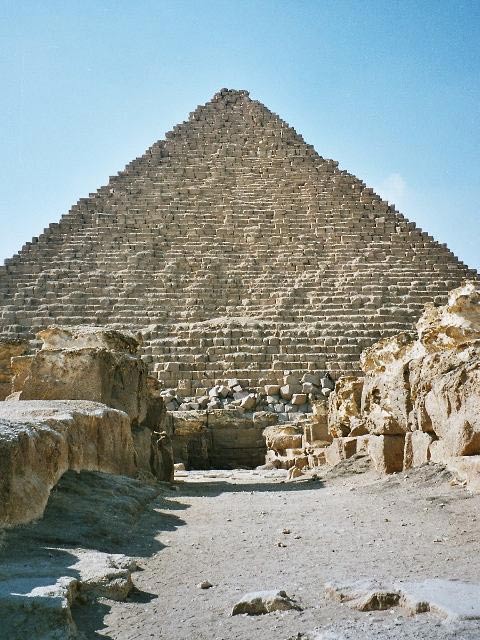
Pyramid of Menkaure Giza Plateau, Egypt (CC BY-SA 3.0)
Khafre’s complex has several anomalies, in both sizes and proportions, compared to the corresponding complexes of the Great Pyramid and Menkaure’s Pyramid. In fact, observing the measurement relationship between major and minor buildings of each monumental complex, we can state that the Khafre complex proportions are directly proportional to the Great Pyramid complex, and inversely proportional to Menkaure’s Pyramid. Differences are due to the sizes of the Pyramids of the Queens in relation to major monuments.
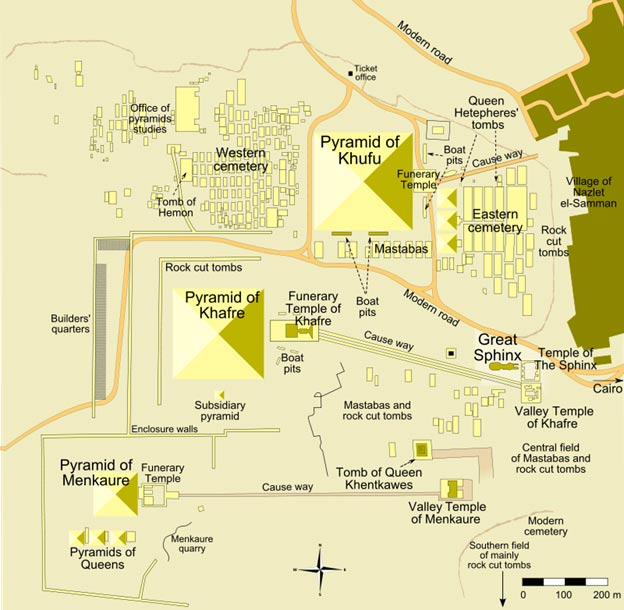
Map of Giza pyramid complex – "Pyramid of Khufu" refers to the Great Pyramid. (CC BY-SA 3.0)
Giza Primary Planning
It is important that we dwell on the very certain aspects of this particular proposal, introducing to the secrets of the monuments arrangement on the Giza Plateau, during the Zep Tepi (the 'First Time' or Golden Era).
If the study of the major pyramids showed main scientific results, even the Satellite Pyramids (or Pyramids of the Queens) should contain scientific information necessary to establish that they were part of the Primary Planning.
When I proposed my Theory of the Zep Tepi in 2010, at Zayed University of Dubai, I suggested that the satellite pyramids could have the following functions, integrated in the Giza Primary Planning:
-They have a numeric value, used to establish the time range between two historic moments, i.e. from Homo sapiens sapiens evolution to the Neanderthal disappearance, culminating with the beginning of the Zep Tepi, when the gods ruled in Egypt, according to mythology.
-They may have an astronomical connection with some stars near the major ones in the Belt of Orion. As the main pyramids have a correlation with the major stars of the Belt of Orion, it is very likely that the minor monuments may have an astronomical connection with objects orbiting Al Nitak (Zeta Orionis) and Mintaka (Delta Orionis).
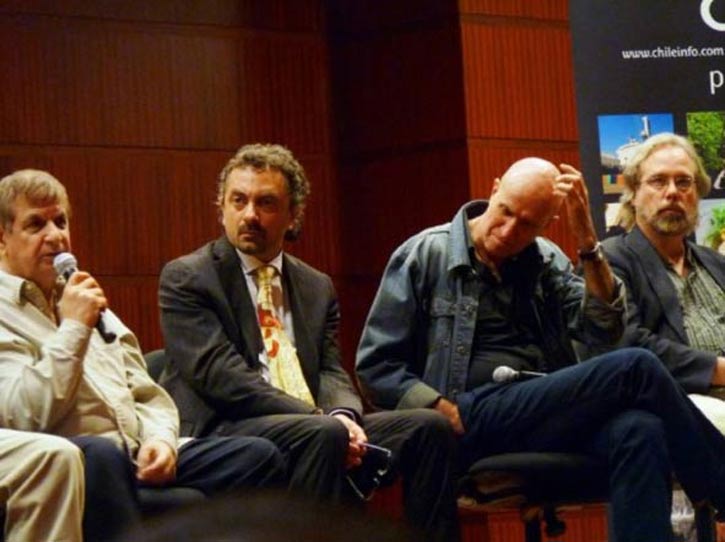
Ahmed Osman, Armando Mei, Robert Bauval and John Major Jenkins. International Conference on Ancient Study, Zayed Univesity, Dubai. (Photo Credit: Armando Mei)
Modern telescopes are unable to observe the existence and dynamic of astronomical objects around the main stars of the Orion Belt. However, some objects have been observed near Al Nitak and Mintaka, implying possible correlations. In the USA, particular studies on this matter are improving, and in the coming years, researchers could receive information that is more detailed.
The civilization which built the monumental complex of Giza, handed down a precise message widely utilizing the architectonic symbolism, which in turn is a physical representation of an historical time, obtained from a mathematical process.
Builders aim to convey a very important message from their time, using the correlation between stars and monuments, and, at the same time, they accurately defined a given period, generating the Zep Tepi. These events are linked to Homo sapiens sapiens evolution and the origins of the Osiris legend.
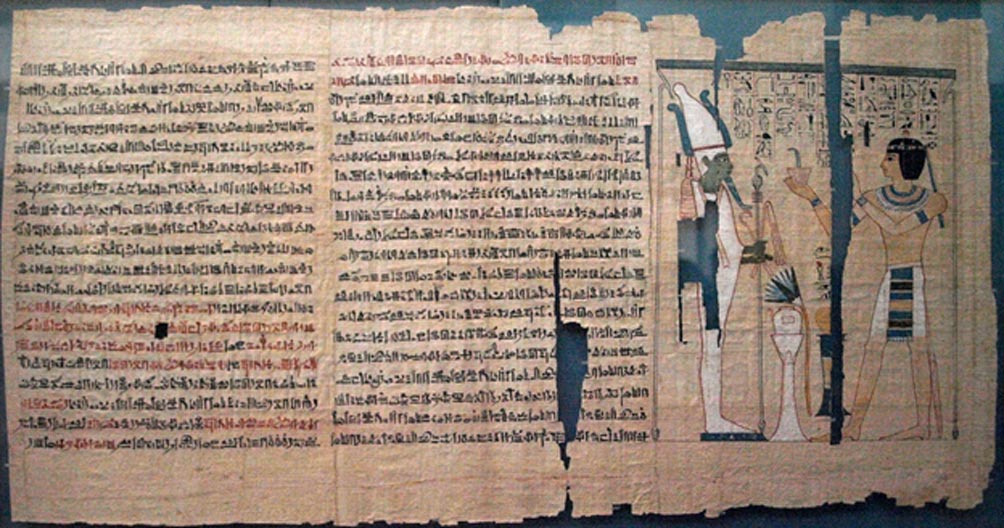
Part of the Book of the Dead of Pinedjem II. The text is hieratic, except for hieroglyphics in the vignette. The use of red pigment, and the joins between papyrus sheets, are also visible. (CC BY-SA 3.0)
In fact, in the Egyptian Book of the Dead, it is said two human species were in conflict: Seth’s followers, the so-called Sebau (cynocephalus) and Osiris’ followers, the Judges of Abydos.
“The day of making Osiris to be victorious over his enemies”
the Gods put an end to the Sebau’s riot until
“their blood floweth among them as they are smitten down”.
The main clues of an anthropological dispute between sapiens and Neanderthal have a vivid literary illustration just as in The Egyptian Book of Dead.
The ancient document gives much more information about the mysteries of Zep Tepi, the wonderful age, during which Egypt witnessed an extremely virtuous process of growth. It was the time when Gods walked among humans, governing the destinies of civilizations.
The Zep Tepi is an historical event so important that they wanted to capture the image of the sky, reproducing it, symbolically, through the monuments.
On that topic, the dispute among scholars and alternative researchers is powerful. A thin line, separating myth from history, becomes well defined when the Zep Tepi contents are so accurately analyzed.
Was the Zep Tepi, the so-called First Time of Osiris, the mythological Golden Age? Was it the time during which arts and sciences reached the apex? When the lost civilization of the pyramids became immortal? Was it the very end of one of the most intriguing civilization of antiquity? Was it the memory celebration, a remembering of the coming of a new species (sapiens and sapiens sapiens) which dominated this globe, overturning the natural order of humanity evolution?
Many questions but few definite answers.
Actually, it is impossible to be certain in this regard. Moreover, artifacts found until now, in any form whatsoever, are not adequate to explain the mystery of the distant past. However, very carefully, I may say that the Zep Tepi was the apex of the Golden Age, during which the lost civilization of Giza wanted to celebrate a new human race domain, arising independently from human evolution theories stated by Darwin.
Another exciting topic is the analysis of the Royal Canon, an ancient papyrus found by Bernardino Drovetti, in 1820… but, that is another story I shall explore the next time. Stay tuned.
Featured image: All Giza Pyramids in one shot. (CC BY-SA 2.0)
References
“The book of Dead” – E.A. Wallace Budge, 1895